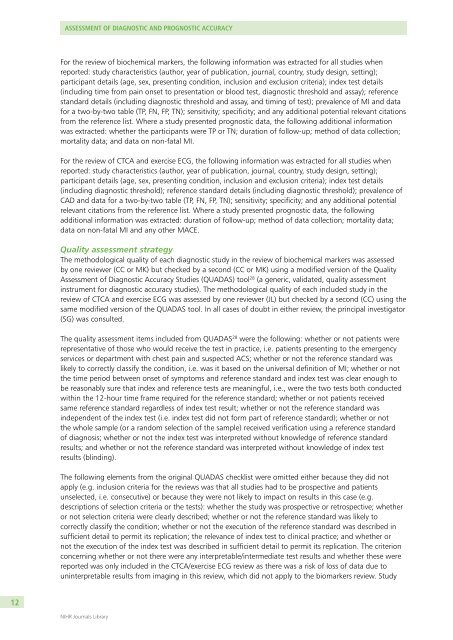Systematic review, meta-analysis and economic modelling of ...
Systematic review, meta-analysis and economic modelling of ...
Systematic review, meta-analysis and economic modelling of ...
You also want an ePaper? Increase the reach of your titles
YUMPU automatically turns print PDFs into web optimized ePapers that Google loves.
Assessment <strong>of</strong> diagnostic <strong>and</strong> prognostic accuracyFor the <strong>review</strong> <strong>of</strong> biochemical markers, the following information was extracted for all studies whenreported: study characteristics (author, year <strong>of</strong> publication, journal, country, study design, setting);participant details (age, sex, presenting condition, inclusion <strong>and</strong> exclusion criteria); index test details(including time from pain onset to presentation or blood test, diagnostic threshold <strong>and</strong> assay); referencest<strong>and</strong>ard details (including diagnostic threshold <strong>and</strong> assay, <strong>and</strong> timing <strong>of</strong> test); prevalence <strong>of</strong> MI <strong>and</strong> datafor a two-by-two table (TP, FN, FP, TN); sensitivity; specificity; <strong>and</strong> any additional potential relevant citationsfrom the reference list. Where a study presented prognostic data, the following additional informationwas extracted: whether the participants were TP or TN; duration <strong>of</strong> follow-up; method <strong>of</strong> data collection;mortality data; <strong>and</strong> data on non-fatal MI.For the <strong>review</strong> <strong>of</strong> CTCA <strong>and</strong> exercise ECG, the following information was extracted for all studies whenreported: study characteristics (author, year <strong>of</strong> publication, journal, country, study design, setting);participant details (age, sex, presenting condition, inclusion <strong>and</strong> exclusion criteria); index test details(including diagnostic threshold); reference st<strong>and</strong>ard details (including diagnostic threshold); prevalence <strong>of</strong>CAD <strong>and</strong> data for a two-by-two table (TP, FN, FP, TN); sensitivity; specificity; <strong>and</strong> any additional potentialrelevant citations from the reference list. Where a study presented prognostic data, the followingadditional information was extracted: duration <strong>of</strong> follow-up; method <strong>of</strong> data collection; mortality data;data on non-fatal MI <strong>and</strong> any other MACE.Quality assessment strategyThe methodological quality <strong>of</strong> each diagnostic study in the <strong>review</strong> <strong>of</strong> biochemical markers was assessedby one <strong>review</strong>er (CC or MK) but checked by a second (CC or MK) using a modified version <strong>of</strong> the QualityAssessment <strong>of</strong> Diagnostic Accuracy Studies (QUADAS) tool 28 (a generic, validated, quality assessmentinstrument for diagnostic accuracy studies). The methodological quality <strong>of</strong> each included study in the<strong>review</strong> <strong>of</strong> CTCA <strong>and</strong> exercise ECG was assessed by one <strong>review</strong>er (JL) but checked by a second (CC) using thesame modified version <strong>of</strong> the QUADAS tool. In all cases <strong>of</strong> doubt in either <strong>review</strong>, the principal investigator(SG) was consulted.The quality assessment items included from QUADAS 28 were the following: whether or not patients wererepresentative <strong>of</strong> those who would receive the test in practice, i.e. patients presenting to the emergencyservices or department with chest pain <strong>and</strong> suspected ACS; whether or not the reference st<strong>and</strong>ard waslikely to correctly classify the condition, i.e. was it based on the universal definition <strong>of</strong> MI; whether or notthe time period between onset <strong>of</strong> symptoms <strong>and</strong> reference st<strong>and</strong>ard <strong>and</strong> index test was clear enough tobe reasonably sure that index <strong>and</strong> reference tests are meaningful, i.e., were the two tests both conductedwithin the 12-hour time frame required for the reference st<strong>and</strong>ard; whether or not patients receivedsame reference st<strong>and</strong>ard regardless <strong>of</strong> index test result; whether or not the reference st<strong>and</strong>ard wasindependent <strong>of</strong> the index test (i.e. index test did not form part <strong>of</strong> reference st<strong>and</strong>ard); whether or notthe whole sample (or a r<strong>and</strong>om selection <strong>of</strong> the sample) received verification using a reference st<strong>and</strong>ard<strong>of</strong> diagnosis; whether or not the index test was interpreted without knowledge <strong>of</strong> reference st<strong>and</strong>ardresults; <strong>and</strong> whether or not the reference st<strong>and</strong>ard was interpreted without knowledge <strong>of</strong> index testresults (blinding).The following elements from the original QUADAS checklist were omitted either because they did notapply (e.g. inclusion criteria for the <strong>review</strong>s was that all studies had to be prospective <strong>and</strong> patientsunselected, i.e. consecutive) or because they were not likely to impact on results in this case (e.g.descriptions <strong>of</strong> selection criteria or the tests): whether the study was prospective or retrospective; whetheror not selection criteria were clearly described; whether or not the reference st<strong>and</strong>ard was likely tocorrectly classify the condition; whether or not the execution <strong>of</strong> the reference st<strong>and</strong>ard was described insufficient detail to permit its replication; the relevance <strong>of</strong> index test to clinical practice; <strong>and</strong> whether ornot the execution <strong>of</strong> the index test was described in sufficient detail to permit its replication. The criterionconcerning whether or not there were any interpretable/intermediate test results <strong>and</strong> whether these werereported was only included in the CTCA/exercise ECG <strong>review</strong> as there was a risk <strong>of</strong> loss <strong>of</strong> data due touninterpretable results from imaging in this <strong>review</strong>, which did not apply to the biomarkers <strong>review</strong>. Study12NIHR Journals Library
















